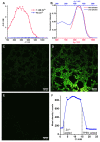A Molecular Hybrid of the GFP Chromophore and 2,2'-Bipyridine: An Accessible Sensor for Zn2+ Detection with Fluorescence Microscopy
- PMID: 38542479
- PMCID: PMC10971390
- DOI: 10.3390/ijms25063504
A Molecular Hybrid of the GFP Chromophore and 2,2'-Bipyridine: An Accessible Sensor for Zn2+ Detection with Fluorescence Microscopy
Abstract
The few commercially available chemosensors and published probes for in vitro Zn2+ detection in two-photon microscopy are compromised by their flawed spectroscopic properties, causing issues in selectivity or challenging multistep syntheses. Herein, we present the development of an effective small molecular GFP chromophore-based fluorescent chemosensor with a 2,2'-bipyridine chelator moiety (GFZnP BIPY) for Zn2+ detection that has straightforward synthesis and uncompromised properties. Detailed experimental characterizations of the free and the zinc-bound compounds within the physiologically relevant pH range are presented. Excellent photophysical characteristics are reported, including a 53-fold fluorescence enhancement with excitation and emission maxima at 422 nm and 492 nm, respectively. A high two-photon cross section of 3.0 GM at 840 nm as well as excellent metal ion selectivity are reported. In vitro experiments on HEK 293 cell culture were carried out using two-photon microscopy to demonstrate the applicability of the novel sensor for zinc bioimaging.
Keywords: 2,2′-bipyridine; DFT; NMR; chelator; chemosensor; fluorescence; two-photon imaging; zinc.
Conflict of interest statement
Balázs Rózsa and Gergely Katona are founders of Femtonics and members of its scientific advisory board. Attila Csomos, Zoltán Mucsi and the other authors declare that no conflicts of interest exist.
Figures






Similar articles
-
A GFP Inspired 8-Methoxyquinoline-Derived Fluorescent Molecular Sensor for the Detection of Zn2+ by Two-Photon Microscopy.Chemistry. 2024 Jun 3;30(31):e202400009. doi: 10.1002/chem.202400009. Epub 2024 Apr 5. Chemistry. 2024. PMID: 38446718
-
A Three-Photon Active Organic Fluorophore for Deep Tissue Ratiometric Imaging of Intracellular Divalent Zinc.Chem Asian J. 2016 May 20;11(10):1523-7. doi: 10.1002/asia.201600170. Epub 2016 Apr 5. Chem Asian J. 2016. PMID: 26991763
-
Amino-Substituted 2,2'-Bipyridine Ligands as Fluorescent Indicators for ZnII and Applications for Fluorescence Imaging of Prostate Cells.Chemistry. 2018 Sep 25;24(54):14539-14546. doi: 10.1002/chem.201803051. Epub 2018 Sep 5. Chemistry. 2018. PMID: 30051526
-
Analyzing free zinc(II) ion concentrations in cell biology with fluorescent chelating molecules.Metallomics. 2015 Feb;7(2):202-11. doi: 10.1039/c4mt00230j. Metallomics. 2015. PMID: 25362967 Review.
-
Heterocyclic Organic Compounds as a Fluorescent Chemosensor for Cell Imaging Applications: A Review.Crit Rev Anal Chem. 2024;54(7):2538-2553. doi: 10.1080/10408347.2023.2186695. Epub 2023 Mar 7. Crit Rev Anal Chem. 2024. PMID: 36880659 Review.
Cited by
-
Introducing Rigidity into the GFP Chromophore via a Boron Bridge: Insights and Application in Two-Photon Imaging.Org Lett. 2025 Apr 4;27(13):3128-3133. doi: 10.1021/acs.orglett.5c00284. Epub 2025 Mar 18. Org Lett. 2025. PMID: 40099802 Free PMC article.
References
-
- Gumienna-Kontecka E., Rowińska-Żyrek M., Łuczkowski M. Recent Advances in Trace Elements. Wiley Online Books; Hoboken, NJ, USA: 2018. The Role of Trace Elements in Living Organisms; pp. 177–206.
-
- Kimura E., Koike T. Recent Development of Zinc-Fluorophores. Chem. Soc. Rev. 1998;27:179–184. doi: 10.1039/a827179z. - DOI
-
- Karolczak K., Guligowska A., Sołtysik B.K., Kostanek J., Kostka T., Watala C. Estimated Intake of Potassium, Phosphorus and Zinc with the Daily Diet Negatively Correlates with ADP-Dependent Whole Blood Platelet Aggregation in Older Subjects. Nutrients. 2024;16:332. doi: 10.3390/nu16030332. - DOI - PMC - PubMed
MeSH terms
Substances
Grants and funding
- 2018-1.3.1-VKE-2018-00032/National Research, Development and Innovation Office
- TKP2021-EGA-42/National Research, Development and Innovation Office
- TKP2021-NVA-14/National Research, Development and Innovation Office
- 2020-1.1.5-GYORSÍTÓSÁV-2021-00004/National Research, Development and Innovation Office
- KFI-18-2018-00097/National Research, Development and Innovation Office
- 2020-2.1.1.-ED-2022-00208/National Research, Development and Innovation Office
- KDP-2021/National Research, Development and Innovation Office
- BO/799/21/7/Hungarian Academy of Sciences
- BO/00365/23/7/Hungarian Academy of Sciences
- ÚNKP-23-ME4/National Research, Development and Innovation Office
- ÚNKP-23-5-BME-460/National Research, Development and Innovation Office
LinkOut - more resources
Full Text Sources
Miscellaneous

